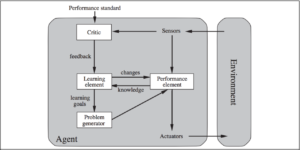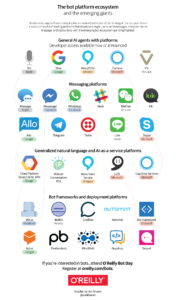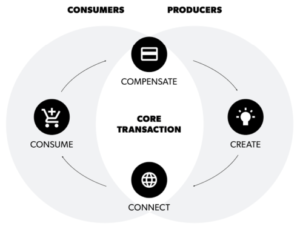Intelligent assistants + Platform business = 1 trillion dollar company?
In the seminal book by Russell & Norvig, Artificial Intelligence – A Modern Approach, the authors describe that “an agent is anything that can be viewed as perceiving its environment through sensors and acting upon that environment through effectors.” Agent programs can be categorized into five progressive types of intelligent systems which include simple reflex agents, model-based reflex agents, goal-based agents, utility-based agents and learning agents. The last category of agents is a learning agent that becomes more competent over time through learning from experiences depicted in the graph below. (1)

Figure 1. A general learning agent (Russell & Norvig 2010: 55)
Learning agents have a learning element that makes improvements and a performance element that selects external actions. The learning element gets feedback on how well the agent is doing from the critic and uses this information to determine how should the performance element be adjusted to do a better job in the future. The learning agent also includes a problem generator that suggests actions that potentially lead to new and informative experiences. (1)
Learning agents have a variety of different names such as bots, droids and virtual or intelligent assistants. In the recent years, there has been an explosive growth in popularity of intelligent assistants which have been applied to variety of use cases ranging from driving and education to financial advice. According to a survey conducted by Oracle, 80% of businesses say they already use or plan to use chatbots by 2020. (2) Market intelligence company Tractica forecasts that total revenue of virtual digital assistants will grow from $1.6 billion in 2015 to $15.8 billion in 2021 worldwide. (3)
Intelligent assistants provide a way for companies to augment and automate their labour intensive manual processes and harness the economies of scale. A number of companies have used chatbots to develop a more scalable customer service experience and during high demand hours chatbots answer simple basic questions and human customer service focuses on more challenging customer problems. This increased efficiency helps companies to accelerate their business transformation and harness the potential of intelligent assistants. (4)
The rapidly growing market demand has mobilized all major technology companies as well as a large amount of startups to develop their propriatery assistant solutions which is depicted in the bot platform ecosystem graph below. (5)

Figure 2. The bot platform ecosystem (Bruner 2016)
The increased demand for intelligent assistants has created a new service industry of technology developers that provide intelligent-assistants-as-a-service. Companies including Alphabet, IBM, Amazon, and Microsoft are creating their bot platform stacks that have a service platform for enterprise clients. These platforms include Google Cloud Platform Speech & NL APIs, IBM Watson Conversation, Amazon Voice Service and Microsoft LUIS and Cognitive Services. (5) These platforms offer a convenient way for companies to integrate intelligence into their products and services and augment their customer experience. The tools enable companies to analyze different customer datasets on a more in-depth level and develop more contextual and meaningful services for their customers’ needs.
Some industry analysts consider Amazon Alexa as the first killer application for intelligent assistants with it’s variety of over 15,000 skills and integrations including Huawei Mate 9, Ford Sync infotainment system, Samsung SmartThings Hub, Philips Hue, Nest Thermostat, Spotify, Uber, Domino’s pizza and Capital One Bank. (6, 7) As more and more services are connected with Alexa, Google Assistant, Siri and Cortana, consumer behaviour starts evolving as customers get use to interacting with intelligent assistants.
Chris Messina, the inventor of the #hashtag and one of the thought leaders in intelligent assistants, talks about the emergence of conversational commerce where customers use natural language interfaces such as chat, messaging and voice to interact with brands and services. This means that customers have interactive conversations directly with brands via Facebook Messenger, WhatsApp, Slack and Telegram. Messina also sees that with time, intelligent assistants will become more human-feeling eventually passing the Turing-test. (8) In the long-term, intelligent assistants will grow to be an even bigger part of the brand experience and AI might become the entire brand itself. (9)
Intelligent assistants are starting to become a part of our everyday lives and facilitate our weekly tasks in cooking, shopping, banking, running a business, dating, entertainment and personal health. As with most products and services, there is only room for one or two platforms that provide this convenience to consumers. The most successful platforms so far are Apple, Google and Facebook. Other platform businesses include Amazon, eBay, Snapchat, Slack, Uber, Airbnb, Pinterest and Square. All of these companies are based on a platform business model which “creates value by facilitating exchanges between two or more interdependent groups, usually consumers and producers.” (10)
Platform businesses develop massive and scalable networks of both users and resources which can easily be accessed on demand. Platform companies create communities that form markets with network effects allowing users to interact with each other and make transactions. Platform companies create value by connecting people and “manufacturing” transactions which is the most important element of designing a platform. Manufacturing is the process of turning potential connections into transactions and generating value for users. This core transaction is essential as the platform needs its users to iterate the process again and again to create and exchange value as depicted in the graph below. (10)

Figure 3. The four steps of the core transaction (Moazed 2016)
A growing number of intelligent platform companies are emerging providing a variety of AI infused services. One fascinating case example of a platform company is Tencent which created the popular WeChat messaging platform that has 938 million monthly average users. WeChat has consolidated a large number of services under one platform and serves as a portal for these services that an average person in China checks more than 10 times per day. As the speed of conversational commerce accelerates, intelligent assistants and artificial intelligence have an enormous potential in facilitating the manufacturing of transactions of the platform within companies like WeChat. When continuously learning intelligent assistants will start to create value for these types of platform companies, we will start to see the emergence of the next 1 trillion dollar company. (11, 12)
Sources:
(1) Russell, Stuart J.; Norvig, Peter (2010), Artificial Intelligence: A Modern Approach (3rd ed.), Upper Saddle River, New Jersey: Prentice Hall, ISBN 0-13-604259-7 (pp. 34, 47, 48, 53-56)
(2) Oracle (2016, December 6). Virtual Reality, Chatbots to Dominate Brand Interactions by 2020. Retrieved at: https://www.oracle.com/uk/corporate/pressrelease/oracle-report-can-virtual-experiences-replace-reality-vr-chatbots-for-cx-20161206.html
(3) Tractica (2016, August 3). The Virtual Digital Assistant Market Will Reach $15.8 Billion Worldwide by 2021. Retrieved at: https://www.tractica.com/newsroom/press-releases/the-virtual-digital-assistant-market-will-reach-15-8-billion-worldwide-by-2021/
(4) McKinsey Global Institute (2017, June). Artificial intelligence – the next digital frontier? Retrieved at: http://www.mckinsey.com/business-functions/mckinsey-analytics/our-insights/how-artificial-intelligence-can-deliver-real-value-to-companies
(5) Bruner, J. (2016, September 17). Infographic: The bot platform ecosystem. O’Reilly. Retrieved at: https://www.oreilly.com/ideas/infographic-the-bot-platform-ecosystem
(6) Perez, S. (2017, July 3). Amazon’s Alexa passes 15,000 skills, up from 10,000 in February. Techcrunch. Retrieved at: https://techcrunch.com/2017/07/03/amazons-alexa-passes-15000-skills-up-from-10000-in-february/?ncid=rss
(7) Wroclawski, D. (2017, May 9). Everything that works with Amazon Echo and Alexa. Reviewed.com. Retrieved at: http://smarthome.reviewed.com/features/everything-that-works-with-amazon-echo-alexa
(8) Messina, C. (2016, January 19). 2016 will be the year of conversational commerce. Medium. Retrieved at: https://medium.com/chris-messina/2016-will-be-the-year-of-conversational-commerce-1586e85e3991
(9) Meeker, M. (2016, June 1). Internet Trends 2016. KPCB. Retrieved at: http://www.kpcb.com/blog/2016-internet-trends-report
(10) Moazed, A. (2016, May 1). What is a Platform? Applico. Retrieved at: https://www.applicoinc.com/blog/what-is-a-platform-business-model/
(11) Long, D. (2017, May 18). Tencent profits and revenues jump as WeChat users grow 23% in Q1. The Drum. Retrieved at: http://www.thedrum.com/news/2017/05/18/tencent-profits-and-revenues-jump-wechat-users-grow-23-q1
(12) Chao, E. (2017, February 1). How WeChat became China’s app for everything. Fast Company. Retrieved at: https://www.fastcompany.com/3065255/china-wechat-tencent-red-envelopes-and-social-money

